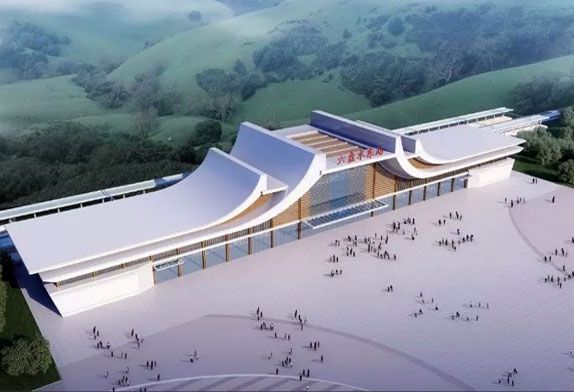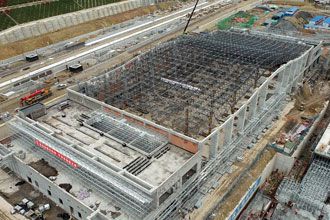 As a public building, the railway passenger station, as a transportation building, has had the most rapid development of cities in recent years. It has its own architectural characteristics. Therefore, there will be many special influencing factors in the design and construction process.
As a public building, the railway passenger station, as a transportation building, has had the most rapid development of cities in recent years. It has its own architectural characteristics. Therefore, there will be many special influencing factors in the design and construction process.
1. Factors affecting the structure of the railway station
1.1 Use function
(1) The scale of the railway station building
The function of the use of the railway passenger station determines its size. According to the scale, the selection of its structural form is determined. Small railway stations can choose the frame structure or steel structure of simple steel concrete. Extra-scale stations use large-span structures.
(2) Real structural form
In the architectural design of the railway passenger station, the structural form conforms to the structural logic, can truly handle the form, and objectively express the spatial state, and the structural form design is in accordance with this principle.
(3) Traffic flow has become a way of life
What is getting closer to Europe is that traffic flow has become a lifestyle. People studying, eating breakfast, working, and communicating on trains have become a space for walking, and the train station has also become a living place. In China, this development trend will also become a possibility.
For example, working in Beijing, returning to Tianjin, and on the intercity high-speed rail, the space changes and lifestyles between Beijing South Railway Station and Tianjin Station. Therefore more important, the core of the aesthetic consciousness of architectural aesthetics has become a new trend of the structural design of the modern railway passenger station.

1.2 Regional
(1) Structural form determines architectural forms
In the architectural design of the railway passenger station, the structural form, determining architectural form, under the influence of regional factors, in the architectural design, more considering the local cultural characteristics and the natural conditions of the climate, reflecting the terrain and local conditions, such as Lhasa, such as Lhasa, Lhasa The railway station echoes the Tibetan cultural style and is integrated with the surrounding mountains.
(2) Appropriate epidermal treatment
In structural design, in order to express a moderate regional culture, appropriate epidermal treatment is allowed to exist. For the artistic expression of architecture, there will be a “finishing touch” effect. For example, the new Sanya Railway Station will be roof, like a giant umbrella, connects the waiting hall and platform into one, not only satisfying the authenticity of the structural form but also giving Hainan’s regional characteristics.
(3) The combination of architecture and topography
In addition to the humanistic connotation, the architectural design is also reflected in the combination of the local terrain and generosity. The marine climate is closely combined.
1.3 Some frame-based design requirements of the Ministry of Railways under the Chinese characteristics
(1) The flow of people is large, and the structural form meets the large space of the Chinese railway passenger station. Especially during the Spring Festival and the student’s winter vacation, the space of the railway station is very crowded. During this special period, the demand for large spaces is very very demand for large spaces very much. Obviously, it is critical to fully consider the bearing capacity of space in the design of key passenger stations.
(2) The structural form should be ascended as possible in order to reduce the inconvenience of use in the building design. In the process of bidding for the Ministry of Railways, there are some unreasonable rules. In China, the Ministry of Railways introduced some similar regulations and detailed design, which is not very reasonable, which limits the development of the architectural design of our railway passenger station.
1.4 Connectivity with urban space
(1) The challenges of the underlying overhead for structural design selection
The railway station has become part of the urban landscape and life. It is integrated into the public space of the city, connecting the traffic between the city and the node of the connection between the city. Common. The underlying overhead has increased challenges in structural design. For material selection and structural design, and bearing capacity, it is a greater requirement. Combined with urban space, making the building is refreshed.
(2) The challenge of the composite space of the railway passenger station for structural form design
Railway stations have become nodes with the largest urban residents and liquidity of urban residents. Therefore, with the development of society, the railway station not only has a single traffic function but also gives business characteristics according to needs. A collection of space. As part of the urban space, the railway passenger station introduces commercial space into the railway station. Although Beijing West Station is not very successful, there are still successful design cases. Take the Kyoto Railway Station of the former Japanese Division as an example. The total construction area is 240,000 square meters, but the actual station area only accounts for more than 10,000 square meters, and only one -twenty -fi of the entire building area. The building collection requires high requirements for structural volume design. The huge rectangular structure, the central part is like a canyon tunnel, combined with reality, and it is also integrated with urban space. The open form and magnificent volume.
(3) Railway station building is an integral part of the urban landscape, and its attributes laid the main role as an essential public space of the city. The masterpiece of the excellent railway passenger station building must be a successful work that fits the development of the times, and it is a successful work that integrates the city’s form and coordinates the urban texture.
As an urban landscape, Taipei Alishan Station adopts a wooden structure. The platform column uses wooden micro-curved columns as a ribbon pillars. In addition to the function of the station, it has also become integrated with Alishan Forest Park. It is a landscape as a landscape. The existence, of railway stations coexisting with natural forests, is also a representative of green buildings in energy conservation and environmental protection.

2 The selection of reasonable architectural structures can become increase the landscape of the city
2.1 There are problems with the structure of the station building
During the initial development period of my country’s railway passenger stations, they blindly imitated Western classicism and other styles. For example, Beijing Railway Station imitated the Soviet model. Later, the practice of elevated waiting for trains and large-scale commercial complexes in Beijing West Railway Station left some disadvantages. The author has brought many lessons and inspirations. Due to the rapid construction and design of high-speed railway stations in recent years, there are still many problems in the selection of structural forms and the practical and artistic treatment of structural forms.
(1) The unreasonable selection of the structure of the railway passenger station is due to the blind pursuit of landmarks and the grandeur of the building in the early stage of the architectural design of the railway passenger station in my country while ignoring the bearing capacity of the building itself. Reasonable selection of structure types, for example, Yantai Railway Station chose a cantilevered shell structure, which is not very reasonable in terms of practicability and aesthetics for decorative effects. If it is based on the economic span, it would be more reasonable to directly choose the grid structure.
(2)The space of railway passenger stations cannot truly reflect the structural form. In the process of participating in the design of an actual high-speed railway station, the phenomenon of many fake structures is quite serious. In order to meet the modeling requirements, the load-bearing structure of circular pillar outsources square stone, which not only causes waste, but also damages the principle of authenticity in aesthetics. The structure is wrapped in unreasonable skin, and the building cannot breathe.
(3) The structure and shape of the railway passenger station increase the cost and waste the loss of high-speed railway stations. The loss of the high-speed railway station that has not yet opened has far exceeded the budget in terms of cost settlement. In many European countries, high-speed railway stations are small and refined. The structural components are exposed, such as the Enschede Railway Station in the Netherlands, which adopts a traditional reinforced concrete structure, and the cost is reasonable. The structure of the small train station, the structural shape is retro, and many skins are placed on the outside, which does not meet the aesthetic requirements and causes waste in terms of cost.
2.2 Difficulties faced
① One of the problems is that the architectural design of railway passenger station can not correctly deal with the relationship between the architectural form and the structure. The architectural form can objectively reflect the form of the structural force, or the surface of the modeling design, and whether the structural form is reasonable in the nonlinear design is very prominent in the architectural design of railway passenger stations. For example, the Lyon Airport Railway Station of Calatrava, based on the biological prototype as the blueprint of the shape design, according to the force analysis of the natural structure, formed the final form, is a relatively successful railway station design.
②Question 2 Unreal structural phenomena in the architectural design of railway passenger stations. The authenticity and rationality of the structural form. In the design practice of railway passenger stations, some structural components are redundant and do not conform to the logic of mechanics. In order to create architectural forms As for the imaginary, it exists in the design of domestic railway passenger stations. For example, many railway stations in China pursue retro forms and use large areas of stone hangings. However, in foreign countries, taking Marseille Railway Station as an example, its stone colonnade serves as a real structural system. The stress-bearing components use the latest prestressed stone, not external components.”











 About Us
About Us 2023-03-03
2023-03-03


